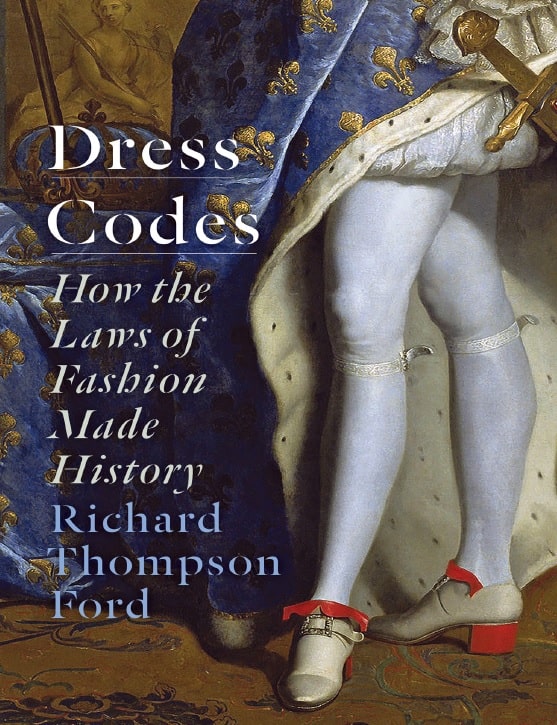Dress Codes: How the Laws of Fashion Made History
by Richard Thompson Ford

Introduction
ACCORDING TO THE JANUARY 16, 1797, edition of the Times of London, John Hetherington, haberdasher of the Strand, was arraigned on a charge of breach of the peace and inciting to riot and required to post bond in the amount of 500 pounds for the following oense:
It was in evidence that Mr. Hetherington… appeared on the public highway wearing upon his head what he called a silk hat (which was oered into evidence), a tall structure having a shining lustre, and calculated to frighten timid people. As a matter of fact, the ocers of the Crown stated that several women fainted at the unusual sight, while children screamed, dogs yelped and a [young man] was thrown down by the crowd which had collected, and had his right arm broken. For these reasons the defendant was seized by the guards and taken before the Lord Mayor.
What rule, written or implied but apparently known to all (even dogs!), did Mr. Hetherington and his headwear violate? Tall, cylindrical hats were common well before the late eighteenth century: for instance, the Puritans of the midseventeenth century wore a severe black felt hat that is now familiar to every American schoolchild as the headwear of the Mayflower pilgrims. And a scant thirty years after Mr. Hetherington’s arrest, the top hat had become an avatar of the staid and self-satisfied plutocrat, marketed with names such as the D’Orsay, the Wellington, and the Regent. What now-obscure code allowed a top hat to be read as a provocation, “calculated to frighten” and deserving of legal sanction?
Unfortunately, we can only speculate: the surviving record of the case begins and ends with this brief newspaper column. It wasn’t the starts time a hat caused a riot and it wouldn’t be the last. For instance, during the notorious Straw Hat Riot of 1922, marauding gangs in New York City violently enforced the rule that no man should wear a straw hat after September 15, knocking oending headwear of the heads of passersby, stomping on the hats and impaling them on pikes. The riots engulfed the city from the Bronx to the Battery: more than one thousand would-be fashion police gathered uptown on Amsterdam Avenue attacking straw-hatted bystanders, while downtown, ghts between the vigilantes and citizens who attempted to defend their hats stopped trac on the Manhattan Bridge.
One might think that such sartorial strictures and prescriptions are largely things of the past: the once-ubiquitous suit and tie, to say nothing of the dressy hat, are almost historical costume. But while dress codes may seem like a throwback, if anything they are growing more and more popular. For instance, in 1999 to 2000, 46.7 percent of U.S. public schools enforced a “strict dress code”— by 2013 to 2014, 58.5 percent did. Millions of people must conform to a dress code every day at work or school, and millions more confront dress codes after hours in restaurants, nightclubs, and theaters. Even the relaxed, bohemian domain of the American coee shop is governed by dress codes: a 2014 dress code dictates that the Starbucks barista must eschew unnatural hair colors, nail polish, short skirts, and piercings other than earrings and subtle nose studs (no septum rings allowed). And dress codes aren’t just for school-age kids and imageconscious private businesses: they are in force on the public streets, where clothing deemed provocative or threatening may be against the law. Those “sagging” pants favored by some rappers and their fans could be grounds for arrest in certain cities, and if police decide they mark you as a member of a gang, they could even turn a minor crime into a capital oense.
Some dress codes not only prescribe and prohibit specic garments but also obsessively dictate the minutia of attire. Consider the 2010 dress code of the Union Bank of Switzerland, a forty-four-page tome that directs employees to avoid chipped nail polish and scued shoes, make sure that jewelry matches the metallic color of eyeglasses, and that neckties just touch the tops of belt buckles.
Exacting and detailed rules about what to wear are everywhere. Consider one small but telling example: today’s masculine formal and semiformal attire is almost a uniform, but it’s a uniform one must assemble through the mastery and application of rules. The canons of menswear dictate that a black-tie ensemble consists of a black or midnight-blue jacket with a peak lapel or shawl collar faced in satin or grosgrain, and pants with the outside seam covered by a silk or grosgrain stripe. If the jacket is double breasted, it must have a peak lapel. If it is single breasted, it can have a peak lapel or shawl collar, but never a notched lapel, which is characteristic of a more quotidian business suit. A cummerbund, worn so that its pleats face up (a nod to the era when men tucked theater tickets into it), must cover the waist, unless the jacket is double breasted, in which case a cummerbund must not be worn. Trousers must be supported by suspenders or “braces”—never a belt—and indeed, the trousers of a semiformal suit must not have belt loops. In 2010, the Wall Street Journal oered many of these rules, as well as a few others, in response to a reader’s inquiry.
